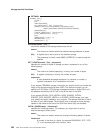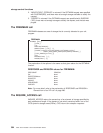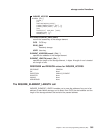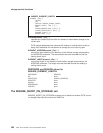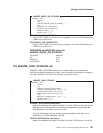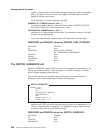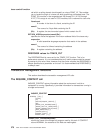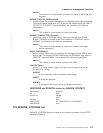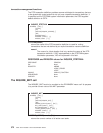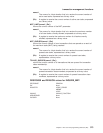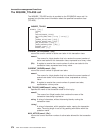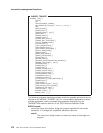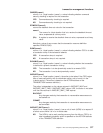
call within a calling domain should specify a unique POINT_ID. This enables
you to locate the origin of a trace call when examining a formatted trace. The
POINT_IDs must be in the range decimal 256 through 511 (X'100' through
X'1FF'). This range is not used in CICS modules, but is reserved for user exits.
literalconst
A number in the form of a literal, containing the ID
name2
The name of a 2-byte field containing the ID
(Rn) A register, the two low-order bytes of which contain the ID.
RETURN_ADDR(expression|name4|(Ra))
specifies the value that appears in the return address field of the trace entry.
expression
A valid assembler-language expression that results in the address
name4
The name of a fullword containing the address
(Ra) A register containing the address.
RESPONSE values for TRACE_PUT
The RESPONSE field is never set for the TRACE_PUT function. This is for
performance reasons. It is not considered that any useful purpose could be served
by testing for this value. Note, however, that the syntax requires that RESPONSE is
always specified as a parameter on the call. It is recommended that RESPONSE(*)
is always used.
Transaction management functions
This section describes the transaction management XPI calls.
The INQUIRE_CONTEXT call
INQUIRE_CONTEXT returns information about the environment in which a
transaction is running. Specifically, it provides information for transactions running in
a bridge environment.
INQUIRE_CONTEXT
DFHBRIQX [CALL,]
[CLEAR,]
[IN,
FUNCTION(INQUIRE_CONTEXT),]
[OUT,
[BRIDGE_EXIT_PROGRAM(name8),]
[BRIDGE_FACILITY_TOKEN(name4),]
[BRIDGE_TRANSACTION_ID(name4),]
[BRXA_TOKEN(name4),]
[CONTEXT(byte1),]
RESPONSE (name1 | *),
REASON (name1 | *)]
BRIDGE_EXIT_PROGRAM(name8)
returns the name of the bridge exit program used by this task. If CONTEXT
returns NORMAL, the contents of this field are meaningless.
trace control function
370
CICS TS for OS/390: CICS Customization Guide



